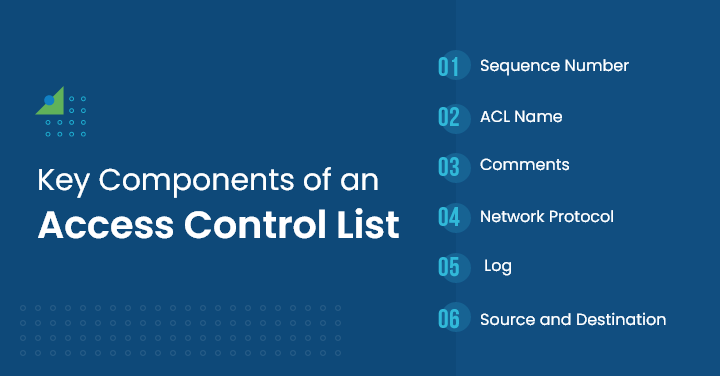What is an Access Control List (ACL)?
An Access Control List (ACL) is an outline of specifications that dictates which particular users and systems are provided or denied access to a specific resource or object.
ACLs are implemented to act as a filter that controls which users can access a network. ACLs can be used as a security measure to monitor access control and prevent unauthorized use.
Key Components of an Access Control List
The key components comprising an Access Control List are as follows:
1. Sequence Number
It serves as the code that helps recognize an ACL entry.
2. ACL Name
The ACL name can be used to identify ACL entries alongside the sequence number.
3. Comments
Network administrators can implement comments or detailed descriptions into an ACL
4. Network Protocol
Network administrators can monitor access to different networks on the basis of a network protocol.
5. Log
Some ACL devices allow administrators to store a log of objects to keep track of network traffic and utilize that data to generate insightful information about the workings of the ACL.
6. Source and Destination
A specific IP address helps determine permissions and access rights based on specific ACLs.
Benefits of Implementing an Access Control List
Establishing an Access Control List provides administrators with a detailed view of network traffic, facilitating the following benefits:
- An ACL can help improve network performance by scaling network traffic.
- Network administrators can adjust user access and traffic permissions at varying points in the network.
- ACLs enable user identification and ensure that only approved traffic is able to have access to a system.
- ACLs enhance security by strictly outlining principles for permission and access rights.
Common Use Cases for Access Control Lists
ACLs can be implemented in a variety of situations to manage traffic and bolster security.
1. Network Security
ACLs can be deployed to improve network security through the granular control of access to network resources.
Administrators can specify which users, IP addresses, and protocols are allowed to access network resources and prevent unauthorized access.
2. Firewall Rules
Firewalls employ ACLs to filter incoming and outgoing traffic based on specified criteria. Network administrators can create ACL rules to block specific IP addresses, restrict access to certain access points, or enforce policies to only allow secure traffic.
3. Virtual Private Networks (VPNs)
ACLs control the traffic flow between VPN clients and servers. Network administrators can use ACL rules to permit or deny VPN connections based on factors like user authentication and source IP address, helping implement security policies for access to networks.
4. Intrusion Prevention Systems (IPS)
ACLs are employed to detect and prevent unauthorized activities within the network. By refining ACL rules to block known malicious IP addresses and unexpected traffic patterns, IPS systems can defend against cyber threats and attempts at unauthorized access.

